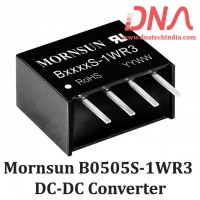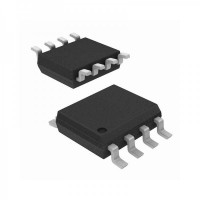Connecting Inductors in Series |
|
Inductors can be connected together in either a series connection, a parallel connection or combinations of both series and parallel together, to produce more complex networks whose overall inductance is a combination of the individual inductors. However, there are certain rules for connecting inductors in series or parallel and these are based on the fact that no mutual inductance or magnetic coupling exists between the individual inductors. |
|
|
Inductors in Series |
|
Inductors are said to be connected in "Series" when they are daisy chained together in a straight line, end to end. In the Resistors in Series tutorial we saw that the different values of the resistances just "add" together and this is also true of inductance. Inductors in series are added together because the number of coil turns is effectively increased, with the total circuit inductance LT being equal to the sum of all the individual inductances added together. |
|
|
Inductor in Series Circuit |
|
|
|
The current, ( I ) that flows through the first inductor, L1 has no other way to go but pass through the second inductor and the third and so on. Then, inductors in series have a Common Current flowing through them, for example: |
|
IL1 = IL2 = IL3 = IAB ...etc. |
|
In the example above, the inductors L1, L2 and L3 are all connected together in series between points A and B. The sum of the individual voltage drops across each inductor can be found using Kirchoff's Voltage Law (KVL) where, VT = V1 + V2 + V3 and we know from the previous tutorials on inductance that the self-induced emf across an inductor is given as: V = L di/dt. |
|
So by taking the values of the individual voltage drops across each inductor in our example above, the total inductance for the series combination is given as: |
|
|
|
By dividing through the above equation by di/dt we can reduce it to give a final expression for calculating the total inductance of a circuit when connecting inductors in series and this is given as: |
|
|
Inductors in Series Equation |
|
Ltotal = L1 + L2 + L3 + ..... + Ln etc. |
|
Then the total inductance of the series chain can be found by simply adding together the individual inductances of the inductors in series just like adding together resistors in series. However, the above equation only holds true when there is "NO" mutual inductance or magnetic coupling between two or more of the inductors, (they are magnetically isolated from each other). |
|
One important point to remember about inductors in series circuits, the total inductance (LT) of any two or more inductors connected together in series will always be GREATER than the value of the largest inductor in the series chain. |
|
|
Example No 1 |
|
Three inductors of 10mH, 40mH and 50mH are connected together in a series combination with no mutual inductance between them. Calculate the total inductance of the series combination. |
|
|
|
|
Mutually Connected Inductors in Series |
|
When inductors are connected together in series so that the magnetic field of one links with the other, the effect of mutual inductance either increases or decreases the total inductance depending upon the amount of magnetic coupling. The effect of this mutual inductance depends upon the distance apart of the coils and their orientation to each other. Mutually connected inductors in series can be classed as either "Aiding" or "Opposing" the total inductance. If the magnetic flux produced by the current flows through the coils in the same direction then the coils are said to be Cumulatively Coupled. If the current flows through the coils in opposite directions then the coils are said to be Differentially Coupled as shown below. |
|
|
Cumulatively Coupled Series Inductors |
|
|
|
While the current flowing between points A and D through the two cumulatively coupled coils is in the same direction, the equation above for the voltage drops across each of the coils needs to be modified to take into account the interaction between the two coils due to the effect of mutual inductance. The self inductance of each individual coil, L1 and L2 respectively will be the same as before but with the addition of M denoting the mutual inductance. |
|
Then the total emf induced into the cumulatively coupled coils is given as: |
|
|
|
Where: 2M represents the influence of coil L 1 on L 2 and likewise coil L 2 on L 1. |
|
By dividing through the above equation by di/dt we can reduce it to give a final expression for calculating the total inductance of a circuit when the inductors are cumulatively connected and this is given as: |
|
Ltotal = L 1 + L 2 + 2M |
|
If one of the coils is reversed so that the same current flows through each coil but in opposite directions, the mutual inductance, M that exists between the two coils will have a cancelling effect on each coil as shown below. |
|
|
Differentially Coupled Series Inductors |
|
|
|
The emf that is induced into coil 1 by the effect of the mutual inductance of coil 2 is in opposition to the self-induced emf in coil 1 as now the same current passes through each coil in opposite directions. To take account of this cancelling effect a minus sign is used with M when the magnetic field of the two coils are differentially connected giving us the final equation for calculating the total inductance of a circuit when the inductors are differentially connected as: |
|
Ltotal = L 1 + L 2 - 2M |
|
Then the final equation for inductively coupled inductors in series is given as: |
|
|
Example No2 |
|
Two inductors of 10mH respectively are connected together in a series combination so that their magnetic fields aid each other giving cumulative coupling. Their mutual inductance is given as 5mH. Calculate the total inductance of the series combination. |
|
|
|
|
Example No3 |
|
Two coils connected in series have a self-inductance of 20mH and 60mH respectively. The total inductance of the combination was found to be 100mH. Determine the amount of mutual inductance that exists between the two coils assuming that they are aiding each other. |
|
|
|
|
Inductors in Series Summary |
|
We now know that we can connect together inductors in series to produce a total inductance value, LT equal to the sum of the individual values, they add together, similar to connecting together resistors in series. However, mutually connected inductors in series are classed as either "aiding" or "opposing" this total inductance depending whether the coils are cumulatively coupled (in the same direction) or differentially coupled (in opposite direction). In the next tutorial about Inductors, we will see that the position of the coils when connecting together Inductors in Parallel also affects the total inductance, LT of the circuit. |
|
|
|
|
|
Reproduced with permission from Wayne Storr |
| ( http://www.electronics-tutorials.ws/inductor/series-inductors.html ) |









